
Brooklands was a 2.75-mile (4.43 km) motor racing circuit and aerodrome built near Weybridge in Surrey, England, United Kingdom. It opened in 1907 and was the world's first purpose-built 'banked' motor racing circuit as well as one of Britain's first airfields, which also became Britain's largest aircraft manufacturing centre by 1918, producing military aircraft such as the Wellington and civil airliners like the Viscount and VC-10.

A race track is a facility built for racing of vehicles, athletes, or animals. A race track also may feature grandstands or concourses. Race tracks are also used in the study of animal locomotion. Some motorsport tracks are called speedways.

Silverstone Circuit is a motor racing circuit in England, near the Northamptonshire villages of Silverstone and Whittlebury. It is the current home of the British Grand Prix, which it first hosted as the 1948 British Grand Prix. The 1950 British Grand Prix at Silverstone was the first race in the newly created World Championship of Drivers. The race rotated between Silverstone, Aintree and Brands Hatch from 1955 to 1986, but settled permanently at the Silverstone track in 1987. The circuit also hosts the British round of the MotoGP series.
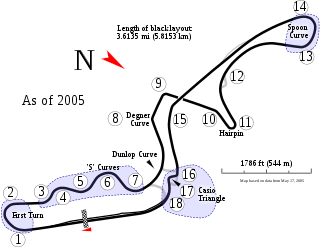
The Suzuka International Racing Course, more famously known as the Suzuka Circuit, is a motorsport race track located in Ino, Suzuka City, Mie Prefecture, Japan and operated by Mobilityland Corporation, a subsidiary of Honda Motor Co, Ltd. It has a capacity of 155,000.

Oval track racing is a form of closed-circuit motorsport that is contested on an oval-shaped race track. An oval track differs from a road course in that the layout resembles an oval with turns in only one direction, and the direction of traffic is almost universally counter-clockwise. Oval tracks are dedicated motorsport circuits, used predominantly in the United States. They often have banked turns and some, despite the name, are not precisely oval, and the shape of the track can vary.

Sebring International Raceway is a road course auto racing facility in the southeastern United States, located near Sebring, Florida.

The Masaryk circuit or Masarykring, also referred to as the Brno Circuit, refers to two motorsport race tracks located in Brno, Czech Republic. The original street circuit was made up of public roads, and at its longest measured 18 miles (29 km). In 1949, events such as the Czechoslovakian Grand Prix attracted top teams and drivers. The track is named after the first president of Czechoslovakia, Tomáš Garrigue Masaryk. Racing on the old roads ended after 1986, when the new (current) circuit was opened.

The Pescara Circuit was a 16.032 miles (25.8 km) race course made up entirely of public roads near Pescara, Italy that hosted the Coppa Acerbo auto race. Pescara is the longest Formula One circuit ever.
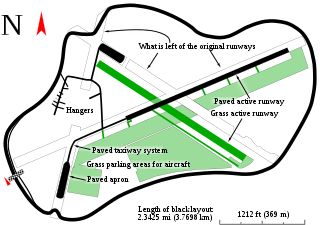
Thruxton Motorsport Centre is a motor-racing circuit located near the village of Thruxton in Hampshire, England which hosts motorsport events including British Touring Cars and Formula 3 racing. It is often referred to as the "Fastest Circuit in the UK" where drivers can reach speeds of over 300 km/h (190 mph) and has earnt the reputation of being a true driver's track. To illustrate this, Damon Hill drove his Williams Formula One car around the circuit at an average speed of 147 mph in 1993.
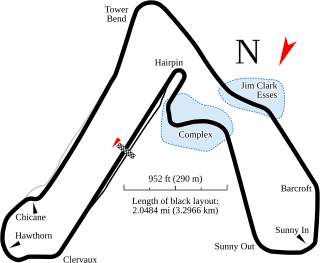
Croft Circuit is a motor racing circuit located near Dalton-on-Tees in North Yorkshire, England. The tarmac circuit is just over 2 miles (3 km) long and is based on the lands of an airfield, but has long since moved on from being a basic airfield circuit. The circuit holds meetings of the British Touring Car Championship, British Rallycross and Pickup Truck Racing race series.
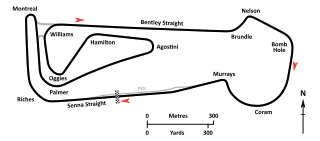
Snetterton Circuit is a motor racing course in Norfolk, England, originally opened in 1953. Owned by Jonathan Palmer's MotorSport Vision organisation, it is situated on the A11 road 12 miles (19 km) north-east of the town of Thetford and 19 miles (31 km) south-west of the city of Norwich. The circuit is named after the nearby village of Snetterton to the north-west of the circuit, although much of the circuit lies in the adjoining civil parish of Quidenham.
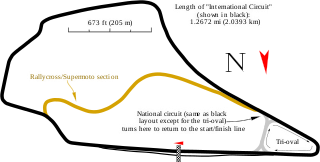
Knockhill Racing Circuit is a motor racing circuit in Fife, Scotland. It opened in September 1974 and is Scotland's national motorsport centre. The circuit is located in the countryside about 6 miles (10 km) north of Dunfermline. It is FIA approved.

Castle Combe Circuit is a motor racing circuit in Wiltshire, England, approximately 20 miles (32 km) from Bristol. The circuit is based on the perimeter track of a former World War II airfield, and was opened for racing in 1950.
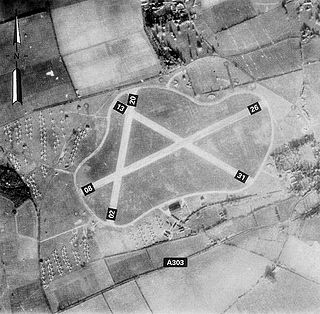
Royal Air Force Thruxton or more simply RAF Thruxton is a former Royal Air Force station located 5 miles (8.0 km) west of Andover, Hampshire and about 66 miles (106 km) southwest of London.

The Royal Automobile Club International Grand Prix was a motor race held on 2 October 1948, at Silverstone Airfield, Northamptonshire, UK. It is commonly cited as the first British Grand Prix of the modern era.

Wigram Airfield Circuit was a temporary motor racing circuit at Wigram Aerodrome, Christchurch, New Zealand. The airfield is a former base of the Royal New Zealand Air Force. It is named after Sir Henry Wigram. The temporary circuit was 3 km with a 1.3 km (0.8mile) main straight. The first summer meetings held at Wigram Aerodrome in 1949 are considered the oldest motor races in New Zealand. The track hosted rounds of the annual Tasman Series from 1964 to 1975. For safety reasons, the last race at Wigram was held in the year 2000.
Davidstow Circuit is a disused motor racing circuit and airfield built in Cornwall, in the United Kingdom. The circuit was built on the site of a World War II RAF Coastal Command base, RAF Davidstow Moor, opened in 1942. Davidstow circuit opened in 1952, and held three Formula 1 races between 1954 and 1955. The circuit hosted its last race in 1955, and was one of many of Britain's airfields to be transformed into motor racing venues. Davidstow circuit is notable for the first victory in a Formula One race by a Lotus.

Rufforth Circuit is a disused motor racing circuit built on an airfield in North Yorkshire, England. Rufforth circuit was built on the site of a World War II bomber base, RAF Rufforth, opened in 1942. The airfield remained in active service after the war, eventually closing in 1954. Rufforth circuit opened in 1959, and held races until 1962. The circuit hosted Formula 2 and Formula Junior races between 1961-1978 as well as numerous sports car events. The circuit was one of many of Britain's airfields to be transformed into motor racing venues.
The Thruxton 500 was a motorcycle endurance race for production based road machines, covering 500 miles and ridden by a team of two riders per machine. The first event was a 9-hour race which took place in 1955, organized by the Southampton and District Motorcycle Club (SDMCC) at the Thruxton Circuit near Andover in Hampshire. Two more 9-hour races followed in 1956 and 1957.
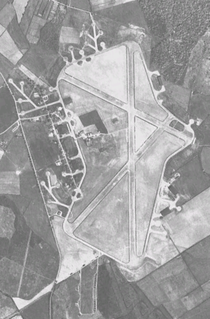
Silverstone Circuit is built on the site of a World War II Royal Air Force bomber station, RAF Silverstone, which opened in 1943. The airfield's three runways, in classic WWII triangle format, lie within the outline of the present track. Since its first use in the 1940s, the circuit has undergone several changes.



















